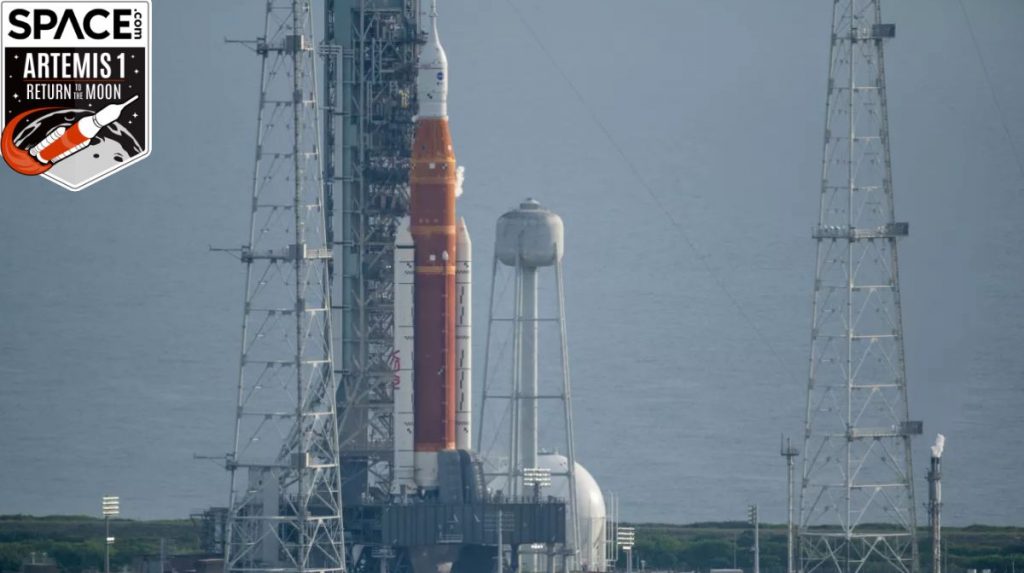NASA aims to get its Artemis 1 moon mission off the ground this weekend despite a recent glitch.
The agency announced today (Aug. 30) that it’s now targeting Saturday (Sept. 3) for the launch of Artemis 1, a crucial mission whose first liftoff attempt on Monday (Aug. 29) was scuttled by a technical issue.
If all goes according to plan, Artemis 1 will launch from Pad 39B at NASA’s Kennedy Space Center (KSC) in Florida during a two-hour window that opens at 2:17 p.m. EDT (1817 GMT). You can watch it here at Space.com when the time comes, courtesy of NASA.
Related: NASA’s Artemis 1 moon mission: Live updates
More: NASA’s Artemis 1 moon mission explained in photos
As its name suggests, Artemis 1 is the first mission of NASA’s Artemis program, which aims to establish a sustainable human presence on and around the moon by the end of the 2020s. It’s also the first flight of NASA’s huge new Space Launch System (SLS) rocket, which will send an uncrewed Orion capsule on a long journey to lunar orbit and back.
That shakeout cruise was supposed to lift off on Monday. During the countdown, however, Artemis 1 team members noticed that one of the four RS-25 engines that power the SLS core stage wasn’t cooling to the desired low temperature — about minus 420 degrees Fahrenheit (minus 250 degrees Celsius) — ahead of ignition.
Such thermal conditioning, achieved via the “bleeding” in of supercold liquid hydrogen propellant, ensures there’s no shock when the engines light up, mission team members have explained. Engines 1, 2 and 4 got close to the mark during the countdown, but number 3 stayed relatively far out of bounds, at roughly minus 380 degrees Fahrenheit (minus 230 Celsius), John Honeycutt, manager of the SLS program at NASA’s Marshall Space Flight Center in Alabama, said during a news conference this evening.
The Artemis 1 team couldn’t troubleshoot the issue in time during Monday’s countdown, so the launch attempt was called off. But Honeycutt and others on the mission team think they have a handle on it now: They suspect it boils down to a faulty temperature sensor on Engine 3.
“I think we understand the physics about how hydrogen performs, and the way the sensor is behaving doesn’t line up with the physics of the situation,” Honeycutt said during this evening’s press conference. Readings from other sensors suggested that Engine 3 was getting appropriate levels of liquid hydrogen during the bleed, he added.
Replacing the sensor would likely require rolling the Artemis 1 stack off Pad 39B and back to KSC’s enormous Vehicle Assembly Building, Honeycutt and others said during the briefing. The Artemis 1 team doesn’t think that’s necessary at this point and instead plans to go ahead with another launch attempt on Saturday.
The team plans to make a few adjustments to the countdown plan — start the engine-cooling process 30 to 45 minutes earlier than last time, for example, And they’ll continue analyzing data and mapping out scenarios over the next few days to make sure that the current approach is indeed justified and prudent, Honeycutt said.
“We’ve got to continue poring over the data,” he said. “We’ve got to put some flight rationale together, anticipating that we’re not going to get any better results on that Engine 3 bleed-temp sensor.”
Such issues are often worked out during a “wet dress rehearsal,” a series of fueling tests and simulated launch countdowns that help vet a brand-new rocket before its first flight. The Artemis 1 team conducted several wet dress attempts at Pad 39B this spring, but they encountered several technical issues and ended up omitting some steps. The wet-dress tries never took Artemis 1 into the “engine bleed” configuration in which the problem was encountered on Monday.
Even if all the technical analyses support a launch attempt on Saturday afternoon, there’s no guarantee Artemis 1 will get off the pad that day. Mother Nature will have a say as well, and the news there is a little iffy.
Mark Berger, a launch weather officer with the U.S. Space Force‘s 45th Weather Squadron, said the latest forecasts show a threat of showers and thunderstorms along Florida’s Space Coast on Saturday. There’s a 60% chance of a weather violation during Saturday’s launch window, Berger said during this evening’s press conference. But he expressed optimism that the weather will clear at some point during the window, giving Artemis 1 a chance to lift off.
Mike Wall is the author of “Out There (opens in new tab)” (Grand Central Publishing, 2018; illustrated by Karl Tate), a book about the search for alien life. Follow him on Twitter @michaeldwall (opens in new tab). Follow us on Twitter @Spacedotcom (opens in new tab) or on Facebook (opens in new tab).

